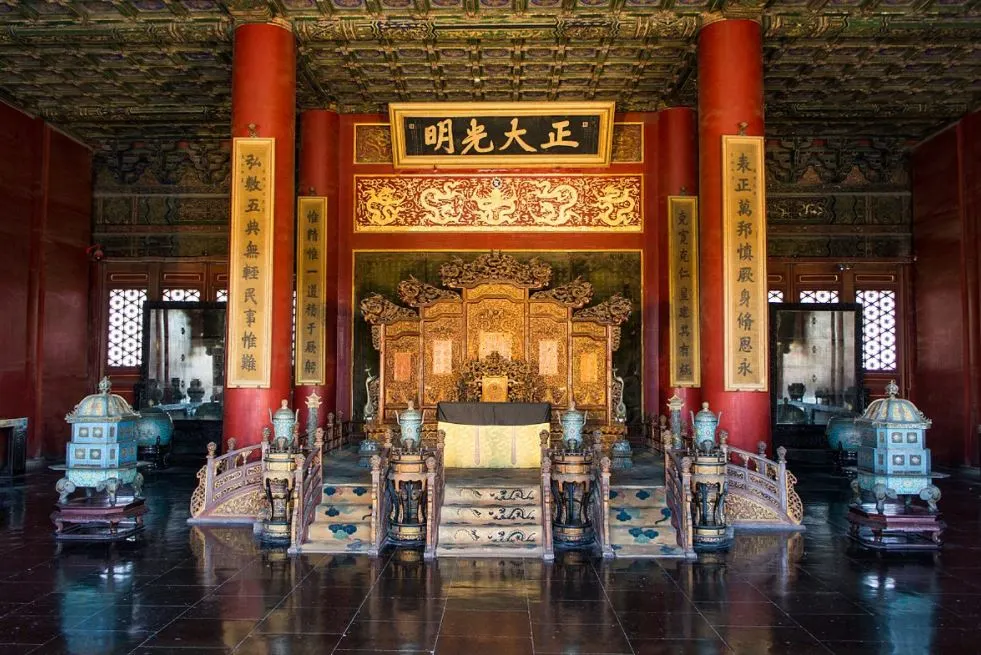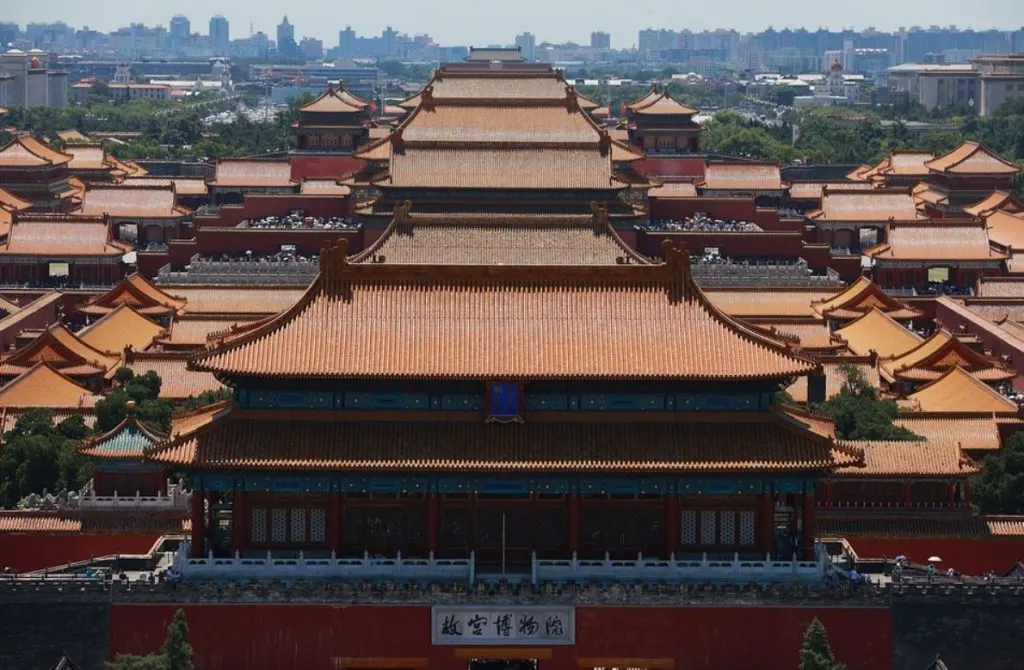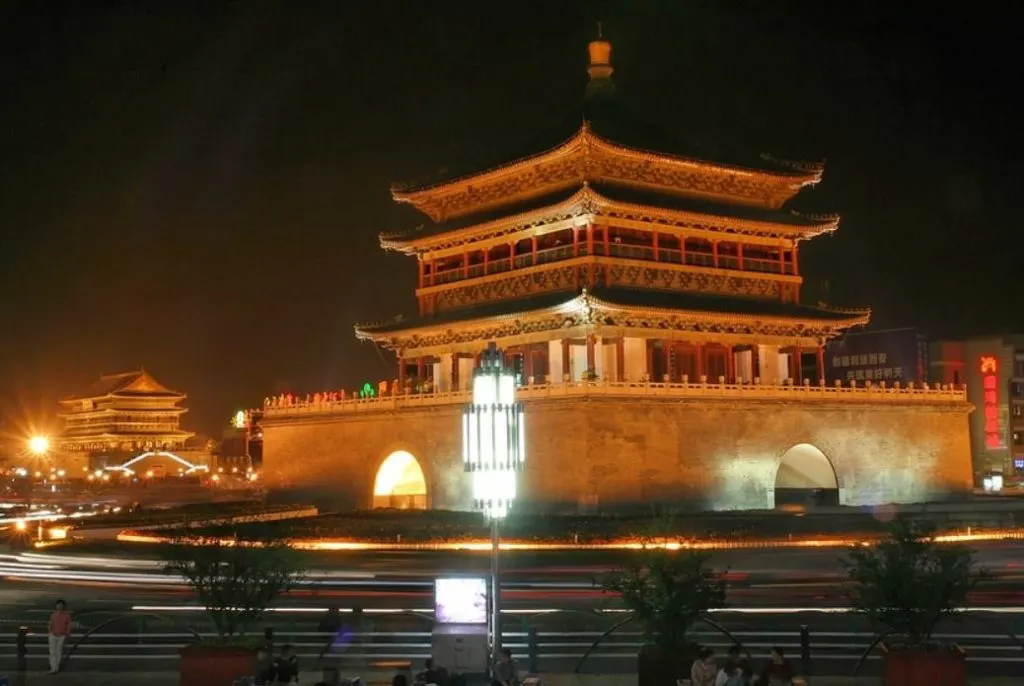One of the most amazing palace complexes can be found in the heart of Beijing, the capital of China. This enormous complex has a history of over 6 centuries and an intriguing name as well.
In this article, you’ll discover the ultimate list of interesting facts about the Forbidden City, one of the most popular tourist attractions in all of China!
1. It’s located just north of the most famous square in Beijing
The Forbidden City is an enormous palace complex located in the center of the Imperial City, right in the heart of Beijing, the capital of the People’s Republic of China.
It’s situated in the Dongcheng District, which translates to “East City District.” That’s why it’s the eastern part of the inner city of Beijing. It’s here that most of the famous landmarks of Beijing are located.
The complex can be found just north of the most famous square in the city called Tiananmen Square. This square features multiple popular tourist attractions such as the Monument to the People’s Heroes, the Great Hall of the People, the National Museum of China, and the Mausoleum of Mao Zedong.
The northern section of the square also features the Tiananmen Gate, a monumental entrance that gives access to the Imperial City.

2. The palace complex was built in the early 15th century
The Tiananmen Gate was built as the main entrance to the Imperial City in the early 15th century during the Ming Dynasty. The entire Forbidden City was constructed between 1406 and 1420.
The construction was started shortly after the Third Emperor of the Ming Dynasty had moved the capital from Nanjing to Beijing. It’s estimated that over a million workers contributed to this enormous construction project.

3. It features nearly 1,000 buildings and almost 8,900 rooms
The scale of the project was enormous as the entire palace complex features 980 buildings. These buildings feature 8,886 rooms and cover an area of 720,000 square meters (72 hectares).
These structures weren’t built with cheap materials as well as they feature durable Phoebe zhennan wood, expensive marble quarried near Beijing, and so-called “golden bricks” specially baked in factories in Suzhou.
The entire complex has the shape of a rectangle with a length of 961 meters (3,153 feet) from north to south and a width of 753 meters (2,470 feet) from east to west. The complex is also protected with an enormous wall of up to 7.9 meters (26 feet) high and a moat of 6 meters (20 feet) deep and 52 meters (171 feet) wide.
This simply means that the complex is big enough to stroll around in it the entire day (or more)!

4. The palace served as the political heart of China for over 500 years
The Forbidden City was the political heart of China from the moment it was completed in 1420 until the end of the Qing Dynasty in 1924.
Even though it mainly served its purpose as the official residence of the Imperial family, it also was both the ceremonial and political center of the Chinese Government for all this time, a period that lasted over 5 centuries!
So why is it called the Forbidden City?
Simply put, because nobody was allowed to either enter or leave the walls of this enormous palace complex without the permission of the Emperor himself. In other words, there was no trespassing for the common man!

5. The complex welcomes nearly 20 million visitors every year
Today, a century after it stopped serving its original purpose as the residence of the Emperor of China and his extensive household, the Forbidden City has been turned into a huge museum.
The complex is in charge of an organization referred to as the “Palace Museum in the Forbidden City” and has become one of the most popular tourist attractions in China as it welcomes over 19 million yearly visitors.
Apart from admiring the amazing traditional Chinese architecture, the museum also houses a total of over 1,860,000 artifacts from both the Ming and Qing Dynasties. These mainly include paintings, ceramics, seals, steles, sculptures, inscribed wares, bronze wares, etc.

More Interesting facts about the Forbidden City
6. The palace complex and Tiananmen Square aren’t the only attractions in the area. It’s surrounded by various Imperial Gardens and temple complexes. These include the Zhongshan Park (22 hectares / 54 acres), the Beihai Park (69 hectares / 171 acres), the Jingshan Park (23 hectares / 57 acres), and the magnificent Imperial Ancestral Temple.
7. Even though the Forbidden City is often described as the largest palace complex in the world, this isn’t actually the case. Believe it or not, but it’s far exceeded in size by multiple other Imperial palaces in China, including Zhongnanhai in Beijing (6.1 square kilometers), the Chengde Mountain Resort in Chengde (5.6 square kilometers), and the Summer Palace in the Haidian District of Beijing (2.9 square kilometers).
8. Because the palace complex consists of 980 buildings of important historical value, its market value has been estimated to be about USD 70 billion. This makes it the most expensive real estate property in the world.
9. If you’re into ceramics and porcelain then the Palace Museum will surely be a treat. It holds an astounding 340,000 pieces, including numerous items from the Tang (618-907 A.D.) and Song (960-1279 A.D.) dynasties as well.
10. The entire complex of the Forbidden City was designated a UNESCO World Heritage site in 1987. The organization describes the complex as a “priceless testimony to Chinese civilization during the Ming and Qing dynasties.”

